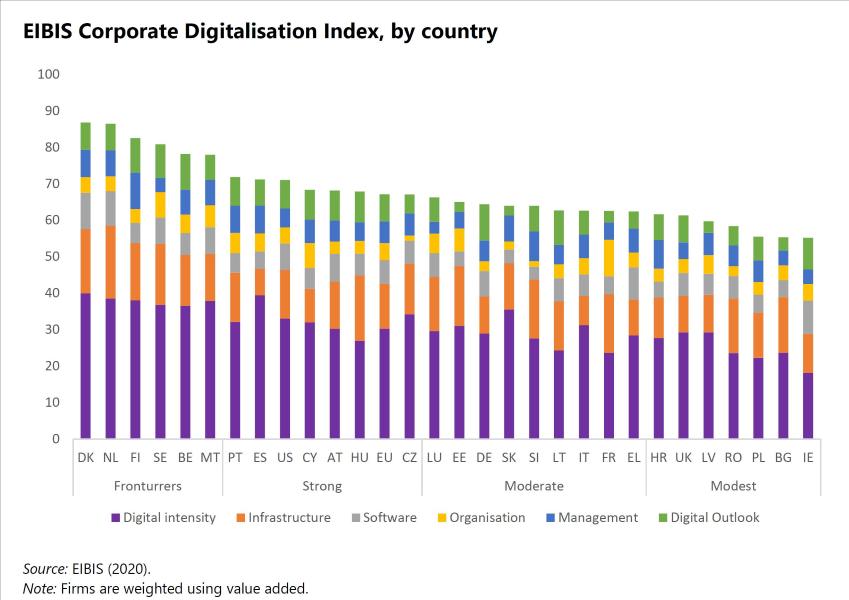Thessaloniki gets ready for its metro launch in November
The underground rapid transit lines have been under construction for almost two decades due to various project delays
 TheMayor.EU logo
TheMayor.EU logo Several EU member states outperform the US in digital adoption efforts
On 21 July, the European Investment Bank (EIB) published the new edition of its annual report: “Digitalisation in Europe 2020-2021: Evidence from the EIB Investment Survey”. This report includes the EIB Corporate Digitalisation Index which assesses the rankings of countries based on the digital adoption efforts of firms in the EU and US.
The study has found that European firms generally lag behind the US in terms of digitalisation. More specifically, this year’s report showed that 37% of European companies (compared to 27% in the US) had still not adopted digital technologies by 2020.
While there is undoubtedly a large digital divide, several EU member states outperform the US in the adoption of digital technology. Taking a look at the EIB Corporate Digitalisation Index, one can see that Denmark ranks highest. In addition to the Nordic country, the Netherlands, Finland, Sweden, Belgium, Portugal, and Spain also outperform the US.

EIB Corporate Digitalisation Index rankings
Source: EIB
Despite the success of the aforementioned countries, it cannot be denied that Europe must do more to bridge the digital divide. According to the EIB, this gap is particularly severe for smaller firms that have less than 50 employees. Taking this further, 60% of micro firms (5-9 employees) do not use any digital technologies while a whopping 75% of firms with over 350 employees are digital. This relationship between the size of firms and the rate of digital adoption is reportedly seen across all sectors of the economy.
The EIB highlights that micro firms and SMEs are the backbone of the EU economy. Moreover, they represent 99% of all businesses and over two-thirds of employment. This, according to the report, is compared with slightly over 40% of US employment. Therefore, it is the difference in the number of small companies that results in the large digital divide between the EU and the US.
Commenting on the need for investments in digital technologies, EIB Vice-President Ricardo Mourinho Félix explained: “The pandemic has shown us the advantages of being digital. That is why we need to be concerned about the slow speed of digitalisation by EU firms. The gap with the US not only jeopardises our long-term competitiveness. A weak European digital sector also means that we will lack ownership of our data.
Increasing digitalisation should therefore be a cornerstone of the recovery. With the EIB, EU policymakers have an efficient instrument at hand to support digitalisation on all levels: from investment in high-speed digital infrastructure to support for startups and financing for small and medium-sized companies or corporates. We stand ready to do more.”
While EU firms may be lagging behind in their adoption of digital technologies, they are excelling in investments that address the green transition and climate change. According to the report, 32% of European companies invest in both digitalisation and climate efforts while only 28% of US companies do so. Furthermore, the percentage of European firms that invest in climate but are not digital (14%) is also nearly 3 times higher than in the US (5%).
Based on its findings, the EIB believes that the EU must do more and invest in digital infrastructure to fully bridge the digitalisation gap. With the creation of more digital firms, the European economy will undoubtedly become stronger as such companies grow faster, support the adaptation of new skills, invest in human capital, and are more profitable than non-digital enterprises.
If you want to keep up with how European cities and regions are changing, follow us on Facebook, Twitter and Instagram.

The underground rapid transit lines have been under construction for almost two decades due to various project delays

Now you can get your wine in Talence by paying directly in Bitcoin

That’s because the state has to spend money on updating the railway infrastructure rather than subsidizing the cost of the popular pass

Rethinking renewable energy sources for the urban landscape

The examples, compiled by Beyond Fossil Fuels, can inform and inspire communities and entrepreneurs that still feel trepidation at the prospect of energy transition

Now you can get your wine in Talence by paying directly in Bitcoin

The 10th European Conference on Sustainable Cities and Towns (ESCT) sets the stage for stronger cooperation between the EU, national and local level to fast track Europe's transition to climate neutrality.

At least, that’s the promise made by the mayor of Paris, Anne Hidalgo

The underground rapid transit lines have been under construction for almost two decades due to various project delays

At least, that’s the promise made by the mayor of Paris, Anne Hidalgo

Hostal de Pinós is located in the geographical centre of the autonomous region

Despite its church-y name, the district has long been known as the hangout spot for the artsy crowds

Urban dwellers across the EU are having a say in making their surroundings friendlier to people and the environment.

Forests in the EU can help green the European construction industry and bolster a continent-wide push for architectural improvements.

Apply by 10 November and do your part for the transformation of European public spaces

An interview with the Mayor of a Polish city that seeks to reinvent itself

An interview with the newly elected ICLEI President and Mayor of Malmö

A conversation with the Mayor of Lisbon about the spirit and dimensions of innovation present in the Portuguese capital














